
Euroregion Silesia is a Euroregion in Poland and the Czech Republic.

Euroregion Silesia is a Euroregion in Poland and the Czech Republic.
The Euroregion comprises 22 gminas on the Polish side (in the counties of Racibórz, Rybnik, Wodzisław in the Silesian Voivodeship and the Glubczyce County in the Opole Voivodeship) and 52 municipalities on the Czech side (in the districts of Opava, Bruntál and Nový Jičín, plus the city of Ostrava). The seat of the Euroregion is located in Opava.
The aim of the Euroregion is to undertake joint activities for the economic and social development of the region and to bring its inhabitants and institutions closer together.
The Euroregion was established in September 1998 under the agreement of the Association of Municipalities of the Upper Oder River on the Polish side [1] and the Regional Association for the Czech-Polish Cooperation Opavian Silesia on the Czech side. [2]

Opole Voivodeship, or Opole Province, is the smallest and least populated voivodeship (province) of Poland. The province's name derives from that of the region's capital and largest city, Opole. It is part of Upper Silesia. A relatively large German minority, with representatives in the Sejm, lives in the voivodeship, and the German language is co-official in 28 communes.
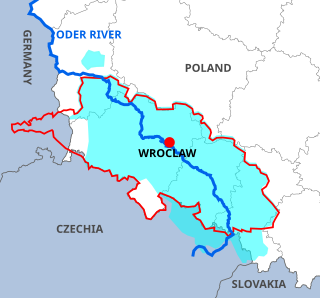
Silesia is a historical region of Central Europe that lies mostly within Poland, with small parts in the Czech Republic and Germany. Its area is approximately 40,000 km2 (15,400 sq mi), and the population is estimated at around 8,000,000. Silesia is split into two main subregions, Lower Silesia in the west and Upper Silesia in the east. Silesia has a diverse culture, including architecture, costumes, cuisine, traditions, and the Silesian language.

Upper Silesia is the southeastern part of the historical and geographical region of Silesia, located today mostly in Poland, with small parts in the Czech Republic.

Opava is a city in the Moravian-Silesian Region of the Czech Republic. It has about 55,000 inhabitants. It lies on the river Opava. Opava is one of the historical centres of Silesia. It was a historical capital of Czech Silesia.

The Province of Silesia was a province of Prussia from 1815 to 1919. The Silesia region was part of the Prussian realm since 1740 and established as an official province in 1815, then became part of the German Empire in 1871. In 1919, as part of the Free State of Prussia within Weimar Germany, Silesia was divided into the provinces of Upper Silesia and Lower Silesia. Silesia was reunified briefly from 1 April 1938 to 27 January 1941 as a province of Nazi Germany before being divided back into Upper Silesia and Lower Silesia.
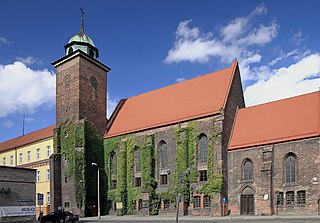
Racibórz is a city in Silesian Voivodeship in southern Poland. It is the administrative seat of Racibórz County.
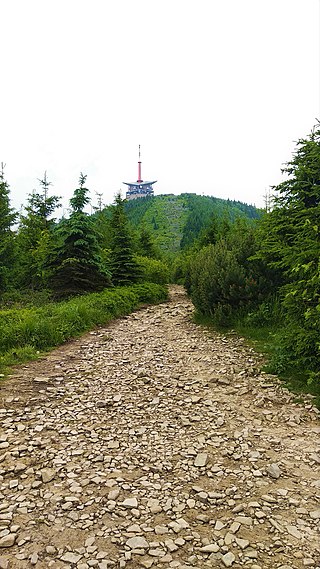
The Moravian-Silesian Region is one of the 14 administrative regions of the Czech Republic. Before May 2001, it was called the Ostrava Region. The region is located in the north-eastern part of its historical region of Moravia and in most of the Czech part of the historical region of Silesia. The region borders the Olomouc Region to the west and the Zlín Region to the south. It also borders two other countries – Poland to the north and Slovakia to the east.

Cieszyn Silesia, Těšín Silesia or Teschen Silesia is a historical region in south-eastern Silesia, centered on the towns of Cieszyn and Český Těšín and bisected by the Olza River. Since 1920 it has been divided between Poland and Czechoslovakia, and later the Czech Republic. It covers an area of about 2,280 square kilometres (880 sq mi) and has about 810,000 inhabitants, of which 1,002 square kilometres (387 sq mi) (44%) is in Poland, while 1,280 square kilometres (494 sq mi) (56%) is in the Czech Republic.

Hlučín Region is a historically significant part of Czech Silesia, now part of the Moravian-Silesian Region in the Czech Republic. It is named after its largest town, Hlučín. Its area is 316.9 km2 (122.4 sq mi), and in 2021, it had 66,750 inhabitants.

Czech Silesia is the part of the historical region of Silesia now in the Czech Republic. Czech Silesia is, together with Bohemia and Moravia, one of the three historical Czech lands.

The Opava is a river in the north-eastern Czech Republic, a left tributary of the Oder river. It originates at the confluence of Bílá (White), Střední (Middle) and Černá (Black) Opava in Vrbno pod Pradědem and runs over 110 km (69 mi) to the Oder at Ostrava, with some 25 km (16 mi) forming the border with Poland. Its basin area is about 2,090 km2, of which 1,814 km2 in the Czech Republic.

Austrian Silesia, officially the Duchy of Upper and Lower Silesia, was an autonomous region of the Kingdom of Bohemia and the Habsburg monarchy. It is largely coterminous with the present-day region of Czech Silesia and was, historically, part of the larger Silesia region.

Lower Silesia is the northwestern part of the historical and geographical region of Silesia; Upper Silesia is to the southeast.
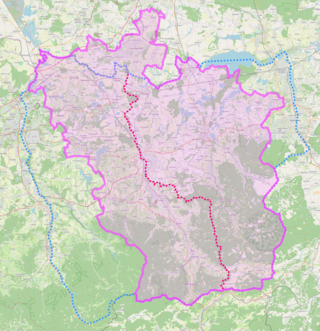
Euroregion Cieszyn Silesia is one of the euroregions between Poland and Czech Republic. It has area of 1741,34 km² and 658,224 inhabitants as of 2009. The largest cities are Jastrzębie Zdrój from Polish side and Havířov from Czech side. It was established on 22 April 1998.
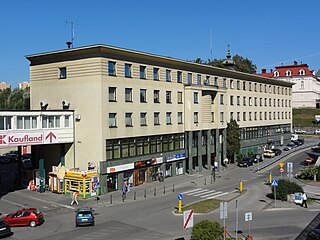
Cieszyn County is a unit of territorial administration and local government (powiat) in Silesian Voivodeship, southern Poland, on the Czech and Slovak border. It came into being on January 1, 1999, as a result of the Polish local government reforms passed in 1998.
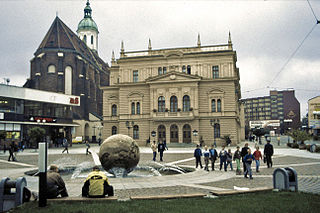
Opava District is a district (okres) within Moravian-Silesian Region of the Czech Republic. Its capital is the city of Opava.

The Oder is a river in Central Europe. It is Poland's second-longest river in total length and third-longest within its borders after the Vistula and Warta. The Oder rises in the Czech Republic and flows 742 kilometres (461 mi) through western Poland, later forming 187 kilometres (116 mi) of the border between Poland and Germany as part of the Oder–Neisse line. The river ultimately flows into the Szczecin Lagoon north of Szczecin and then into three branches that empty into the Bay of Pomerania of the Baltic Sea.

Brumovice is a municipality and village in Opava District in the Moravian-Silesian Region of the Czech Republic. It has about 1,500 inhabitants.

Silesians Together is Silesian regionalist political party in Poland founded in August 2017 by Witold Berus, Andrzej Rocznioek and Leon Swaczyna. The party was founded with the idea of creating a Silesian party that would work with the German minority, a concept that originated in 2014.

The coat of arms of Lower Silesia, and simultaneously of Silesia, shows a black eagle with silver crescent with cross in the middle on its chest on a golden background. It has been assumed in the tradition that the coat of arms and colors of Lower Silesia are simultaneously used as symbols of Silesia as a whole.